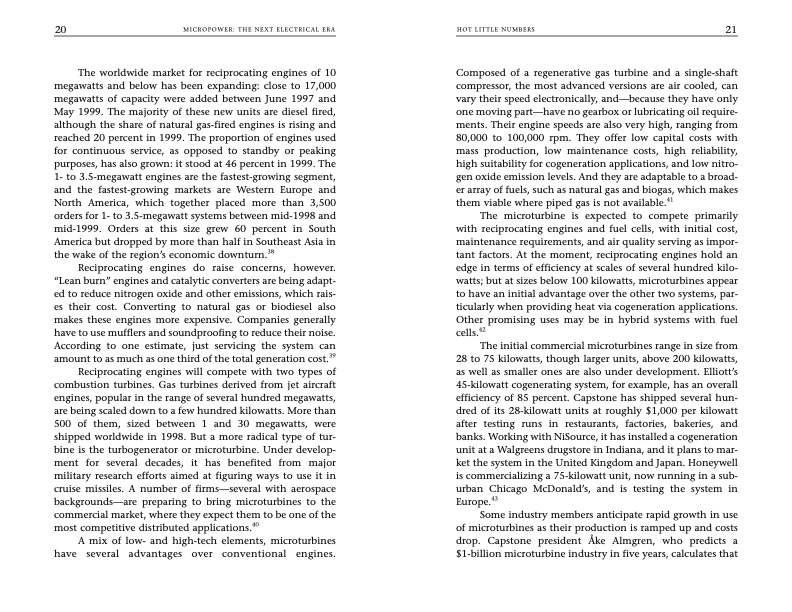
PDF Publication Title:
Text from PDF Page: 011
20 MICROPOWER: THE NEXT ELECTRICAL ERA HOT LITTLE NUMBERS 21 The worldwide market for reciprocating engines of 10 megawatts and below has been expanding: close to 17,000 megawatts of capacity were added between June 1997 and May 1999. The majority of these new units are diesel fired, although the share of natural gas-fired engines is rising and reached 20 percent in 1999. The proportion of engines used for continuous service, as opposed to standby or peaking purposes, has also grown: it stood at 46 percent in 1999. The 1- to 3.5-megawatt engines are the fastest-growing segment, and the fastest-growing markets are Western Europe and North America, which together placed more than 3,500 orders for 1- to 3.5-megawatt systems between mid-1998 and mid-1999. Orders at this size grew 60 percent in South America but dropped by more than half in Southeast Asia in the wake of the region’s economic downturn.38 Reciprocating engines do raise concerns, however. “Lean burn” engines and catalytic converters are being adapt- ed to reduce nitrogen oxide and other emissions, which rais- es their cost. Converting to natural gas or biodiesel also makes these engines more expensive. Companies generally have to use mufflers and soundproofing to reduce their noise. According to one estimate, just servicing the system can amount to as much as one third of the total generation cost.39 Reciprocating engines will compete with two types of combustion turbines. Gas turbines derived from jet aircraft engines, popular in the range of several hundred megawatts, are being scaled down to a few hundred kilowatts. More than 500 of them, sized between 1 and 30 megawatts, were shipped worldwide in 1998. But a more radical type of tur- bine is the turbogenerator or microturbine. Under develop- ment for several decades, it has benefited from major military research efforts aimed at figuring ways to use it in cruise missiles. A number of firms—several with aerospace backgrounds—are preparing to bring microturbines to the commercial market, where they expect them to be one of the most competitive distributed applications.40 A mix of low- and high-tech elements, microturbines have several advantages over conventional engines. Composed of a regenerative gas turbine and a single-shaft compressor, the most advanced versions are air cooled, can vary their speed electronically, and—because they have only one moving part—have no gearbox or lubricating oil require- ments. Their engine speeds are also very high, ranging from 80,000 to 100,000 rpm. They offer low capital costs with mass production, low maintenance costs, high reliability, high suitability for cogeneration applications, and low nitro- gen oxide emission levels. And they are adaptable to a broad- er array of fuels, such as natural gas and biogas, which makes them viable where piped gas is not available.41 The microturbine is expected to compete primarily with reciprocating engines and fuel cells, with initial cost, maintenance requirements, and air quality serving as impor- tant factors. At the moment, reciprocating engines hold an edge in terms of efficiency at scales of several hundred kilo- watts; but at sizes below 100 kilowatts, microturbines appear to have an initial advantage over the other two systems, par- ticularly when providing heat via cogeneration applications. Other promising uses may be in hybrid systems with fuel cells.42 The initial commercial microturbines range in size from 28 to 75 kilowatts, though larger units, above 200 kilowatts, as well as smaller ones are also under development. Elliott’s 45-kilowatt cogenerating system, for example, has an overall efficiency of 85 percent. Capstone has shipped several hun- dred of its 28-kilowatt units at roughly $1,000 per kilowatt after testing runs in restaurants, factories, bakeries, and banks. Working with NiSource, it has installed a cogeneration unit at a Walgreens drugstore in Indiana, and it plans to mar- ket the system in the United Kingdom and Japan. Honeywell is commercializing a 75-kilowatt unit, now running in a sub- urban Chicago McDonald’s, and is testing the system in Europe.43 Some industry members anticipate rapid growth in use of microturbines as their production is ramped up and costs drop. Capstone president Åke Almgren, who predicts a $1-billion microturbine industry in five years, calculates thatPDF Image | Micropower: The Next Electrical Era

PDF Search Title:
Micropower: The Next Electrical EraOriginal File Name Searched:
EWP151.pdfDIY PDF Search: Google It | Yahoo | Bing
Capstone Turbine and Microturbine: Capstone microturbines used and new surplus for sale listing More Info
Consulting and Strategy Services: Need help with Capstone Turbine, sizing systems, applications, or renewable energy strategy, we are here to assist More Info
Container Lumber Dry Kiln: Since 1991 developing and innovating dry kilns using standard shipping containers More Info
Supercritical CO2 Lumber Dry Kiln: Compact fast drying in 3 days or less for small amounts of wood and lumber drying More Info
BitCoin Mining: Bitcoin Mining and Cryptocurrency... More Info
Publications: Capstone Turbine publications for microturbine and distributed energy More Info
FileMaker Software for Renewable Energy Developing database software for the renewable energy industry More Info
CO2 Gas to Liquids On-Demand Production Cart Developing a supercritical CO2 to alcohol on-demand production system (via Nafion reverse fuel cell) More Info
Stranded Gas for low cost power Bitcoin Mining Using stranded gas for generators may provide breakthrough low power costs for cryptocurrency miners. More Info
| CONTACT TEL: 608-238-6001 Email: greg@globalmicroturbine.com | RSS | AMP |